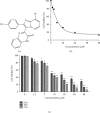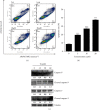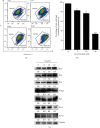A Novel Imidazopyridine Derivative Exerts Anticancer Activity by Inducing Mitochondrial Pathway-Mediated Apoptosis
- PMID: 32908894
- PMCID: PMC7468608
- DOI: 10.1155/2020/4929053
A Novel Imidazopyridine Derivative Exerts Anticancer Activity by Inducing Mitochondrial Pathway-Mediated Apoptosis
Abstract
Background: Cancer remains a major clinical challenge because of the lack of effective drug for its treatment. To find out novel cancer chemotherapeutic molecules, we explored the anticancer effect of novel imidazopyridine compound 9i and also investigated the underlying molecular mechanism.
Methods: Human cervical cancer cell (HeLa) viability was measured by an MTT assay after treatment with compound 9i. Clonogenicity of HeLa cells was investigated by an in vitro colony formation assay. Cell death was visualized by propidium iodide (PI) staining. Fluorescence-activated cell sorting (FACS) was used to determine apoptosis and mitochondrial membrane potential in HeLa cells. The expression level of apoptosis-related proteins was also determined by western blot.
Results: Compound 9i suppressed HeLa cell viability in a time- and dose-dependent manner. Compound 9i induced mitochondrial outer membrane permeabilization (MOMP), activated caspase cascade, and finally resulted in apoptosis.
Conclusion: Compound 9i induces mitochondrial pathway-mediated apoptosis in human cervical cancer cells, suggesting that 9i could be a potential lead compound to be developed as a cancer therapeutic molecule.
Copyright © 2020 Juanli Wang et al.
Conflict of interest statement
The authors declare no conflict of interest.
Figures





Similar articles
-
Delicaflavone induces apoptosis via mitochondrial pathway accompanying G2/M cycle arrest and inhibition of MAPK signaling cascades in cervical cancer HeLa cells.Phytomedicine. 2019 Sep;62:152973. doi: 10.1016/j.phymed.2019.152973. Epub 2019 May 25. Phytomedicine. 2019. PMID: 31177019
-
Design, synthesis and biological evaluation of novel β-pinene-based thiazole derivatives as potential anticancer agents via mitochondrial-mediated apoptosis pathway.Bioorg Chem. 2019 Mar;84:468-477. doi: 10.1016/j.bioorg.2018.12.010. Epub 2018 Dec 10. Bioorg Chem. 2019. PMID: 30576910
-
New Hybrid Scaffolds Based on Carbazole-Chalcones as Potent Anticancer Agents.Anticancer Agents Med Chem. 2021;21(9):1082-1091. doi: 10.2174/1871520620666200721110732. Anticancer Agents Med Chem. 2021. PMID: 32698741
-
A Litopenaeus vannamei Hemocyanin-Derived Antimicrobial Peptide (Peptide B11) Attenuates Cancer Cells' Proliferation.Molecules. 2018 Dec 5;23(12):3202. doi: 10.3390/molecules23123202. Molecules. 2018. PMID: 30563041 Free PMC article.
-
Synthesis of Substituted Cinnamido Linked Quinazolinone Congeners as Potential Anticancer Agents via Mitochondrial Dependent Intrinsic Apoptotic Pathway.Anticancer Agents Med Chem. 2019;19(16):1935-1948. doi: 10.2174/1871520619666190906162537. Anticancer Agents Med Chem. 2019. PMID: 31490766 Review.
Cited by
-
Imidazopyridine Family: Versatile and Promising Heterocyclic Skeletons for Different Applications.Molecules. 2024 Jun 5;29(11):2668. doi: 10.3390/molecules29112668. Molecules. 2024. PMID: 38893542 Free PMC article. Review.
-
Imidazo[1,2-A]Pyridine: Potent Biological Activity, SAR and Docking Investigations (2017-2022).Infect Disord Drug Targets. 2024;24(8):e200324228067. doi: 10.2174/0118715265274067240223040333. Infect Disord Drug Targets. 2024. PMID: 38509674 Review.
-
Identification of a New Promising BAG3 Modulator Featuring the Imidazopyridine Scaffold.Molecules. 2024 Oct 25;29(21):5051. doi: 10.3390/molecules29215051. Molecules. 2024. PMID: 39519692 Free PMC article.
-
Synthesis of imidazopyridines via NaIO4/TBHP-promoted (3 + 2) cycloaddition and biological evaluation as anticancer agents.RSC Adv. 2025 May 12;15(20):15497-15504. doi: 10.1039/d5ra01949d. eCollection 2025 May 12. RSC Adv. 2025. PMID: 40365224 Free PMC article.
-
Biological evaluation, docking studies, and in silico ADME prediction of some pyrimidine and pyridine derivatives as potential EGFRWT and EGFRT790M inhibitors.J Enzyme Inhib Med Chem. 2023 Dec;38(1):176-191. doi: 10.1080/14756366.2022.2135512. J Enzyme Inhib Med Chem. 2023. PMID: 36317648 Free PMC article.
References
-
- Shinde M. H., Kshirsagar U. A. One pot synthesis of substituted imidazopyridines and thiazoles from styrenes in water assisted by NBS. Green Chemistry. 2016;18(6):1455–1458. doi: 10.1039/C5GC02771C. - DOI
-
- Martínez-Urbina M. A., Zentella A., Vilchis-Reyes M. A., et al. 6-Substituted 2-(N-trifluoroacetylamino)imidazopyridines induce cell cycle arrest and apoptosis in SK-LU-1 human cancer cell line. European Journal of Medicinal Chemistry. 2010;45(3):1211–1219. doi: 10.1016/j.ejmech.2009.11.049. - DOI - PubMed
MeSH terms
Substances
LinkOut - more resources
Full Text Sources
Research Materials
Miscellaneous

